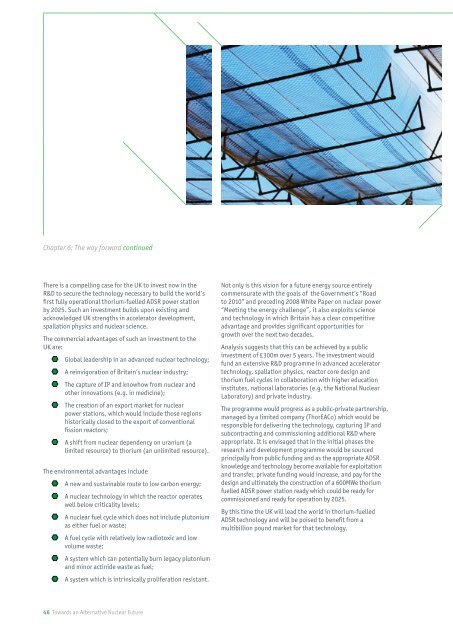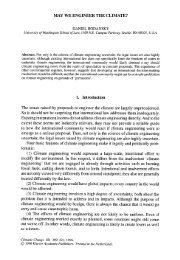ThorEA - Towards an Alternative Nuclear Future.pdf
ThorEA - Towards an Alternative Nuclear Future.pdf
ThorEA - Towards an Alternative Nuclear Future.pdf
Create successful ePaper yourself
Turn your PDF publications into a flip-book with our unique Google optimized e-Paper software.
Chapter 6: The way forward continued<br />
There is a compelling case for the UK to invest now in the<br />
R&D to secure the technology necessary to build the world’s<br />
first fully operational thorium-fuelled ADSR power station<br />
by 2025. Such <strong>an</strong> investment builds upon existing <strong>an</strong>d<br />
acknowledged UK strengths in accelerator development,<br />
spallation physics <strong>an</strong>d nuclear science.<br />
The commercial adv<strong>an</strong>tages of such <strong>an</strong> investment to the<br />
UK are:<br />
Global leadership in <strong>an</strong> adv<strong>an</strong>ced nuclear technology;<br />
A reinvigoration of Britain’s nuclear industry;<br />
The capture of IP <strong>an</strong>d knowhow from nuclear <strong>an</strong>d<br />
other innovations (e.g. in medicine);<br />
The creation of <strong>an</strong> export market for nuclear<br />
power stations, which would include those regions<br />
historically closed to the export of conventional<br />
fission reactors;<br />
A shift from nuclear dependency on ur<strong>an</strong>ium (a<br />
limited resource) to thorium (<strong>an</strong> unlimited resource).<br />
The environmental adv<strong>an</strong>tages include<br />
A new <strong>an</strong>d sustainable route to low carbon energy;<br />
A nuclear technology in which the reactor operates<br />
well below criticality levels;<br />
A nuclear fuel cycle which does not include plutonium<br />
as either fuel or waste;<br />
A fuel cycle with relatively low radiotoxic <strong>an</strong>d low<br />
volume waste;<br />
A system which c<strong>an</strong> potentially burn legacy plutonium<br />
<strong>an</strong>d minor actinide waste as fuel;<br />
A system which is intrinsically proliferation resist<strong>an</strong>t.<br />
46 <strong>Towards</strong> <strong>an</strong> <strong>Alternative</strong> <strong>Nuclear</strong> <strong>Future</strong><br />
Not only is this vision for a future energy source entirely<br />
commensurate with the goals of the Government’s “Road<br />
to 2010” <strong>an</strong>d preceding 2008 White Paper on nuclear power<br />
“Meeting the energy challenge”, it also exploits science<br />
<strong>an</strong>d technology in which Britain has a clear competitive<br />
adv<strong>an</strong>tage <strong>an</strong>d provides signific<strong>an</strong>t opportunities for<br />
growth over the next two decades.<br />
Analysis suggests that this c<strong>an</strong> be achieved by a public<br />
investment of £300m over 5 years. The investment would<br />
fund <strong>an</strong> extensive R&D programme in adv<strong>an</strong>ced accelerator<br />
technology, spallation physics, reactor core design <strong>an</strong>d<br />
thorium fuel cycles in collaboration with higher education<br />
institutes, national laboratories (e.g. the National <strong>Nuclear</strong><br />
Laboratory) <strong>an</strong>d private industry.<br />
The programme would progress as a public-private partnership,<br />
m<strong>an</strong>aged by a limited comp<strong>an</strong>y (<strong>ThorEA</strong>Co) which would be<br />
responsible for delivering the technology, capturing IP <strong>an</strong>d<br />
subcontracting <strong>an</strong>d commissioning additional R&D where<br />
appropriate. It is envisaged that in the initial phases the<br />
research <strong>an</strong>d development programme would be sourced<br />
principally from public funding <strong>an</strong>d as the appropriate ADSR<br />
knowledge <strong>an</strong>d technology become available for exploitation<br />
<strong>an</strong>d tr<strong>an</strong>sfer, private funding would increase, <strong>an</strong>d pay for the<br />
design <strong>an</strong>d ultimately the construction of a 600MWe thorium<br />
fuelled ADSR power station ready which could be ready for<br />
commissioned <strong>an</strong>d ready for operation by 2025.<br />
By this time the UK will lead the world in thorium-fuelled<br />
ADSR technology <strong>an</strong>d will be poised to benefit from a<br />
multibillion pound market for that technology.



